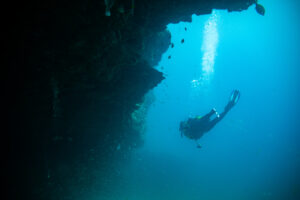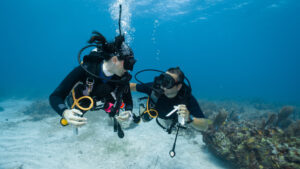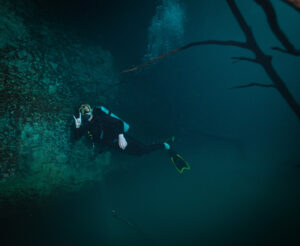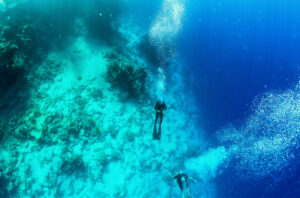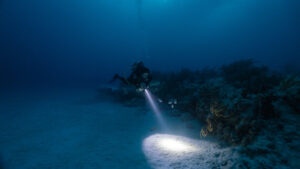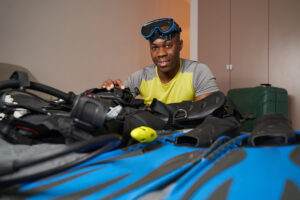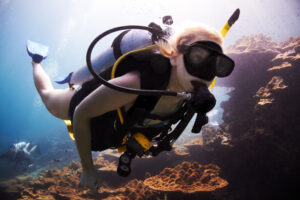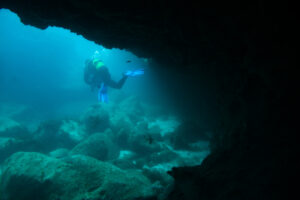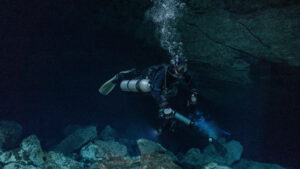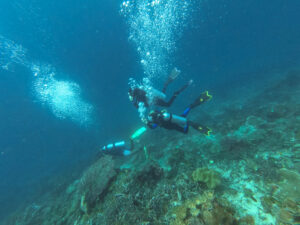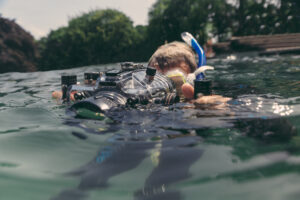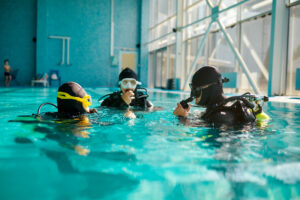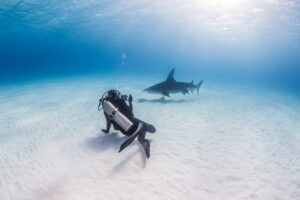What is an Electronic Closed Circuit Rebreather?
An electronic closed circuit rebreather (ECCR) is an advanced type of breathing apparatus used in scuba diving. Unlike traditional open-circuit systems, which release exhaled gases into the water, ECCRs recycle the diver’s exhaled breath by removing carbon dioxide and adding oxygen. This sophisticated technology allows divers to maintain optimal gas mixtures at various depths, significantly extending underwater time and reducing the amount of gas needed. ECCRs have become essential in technical, recreational, and military diving, offering enhanced efficiency and safety. Their development marks a significant milestone in underwater exploration, providing divers with unprecedented capabilities.
Historical Development
The concept of rebreathers dates back to the early 20th century when inventors sought methods to extend underwater excursions without the limitations of surface-supplied air or bulky tanks. The initial designs were rudimentary and often unreliable, but they laid the groundwork for future advancements. During World War II, the need for stealthy underwater operations led to significant innovations in rebreather technology, particularly for military divers. These early systems were largely mechanical and semi-closed, providing a limited but crucial extension of dive times.
Post-war, the interest in diving grew, and with it, the demand for more efficient rebreathers. The 1960s and 1970s saw the introduction of more reliable and safer rebreather systems, thanks to advancements in materials and engineering. However, it wasn’t until the advent of microelectronics and sophisticated sensors in the late 20th century that electronic closed circuit rebreathers became feasible. The integration of electronics allowed for precise monitoring and control of gas mixtures, significantly improving the safety and functionality of rebreathers.
Modern ECCRs represent the culmination of decades of innovation. Companies specializing in diving equipment have developed highly reliable systems that are now used by divers worldwide. These advancements have opened new frontiers in underwater exploration, enabling divers to undertake longer and deeper dives with greater safety and efficiency.
Components and Functionality
An electronic closed circuit rebreather consists of several critical components, each playing a vital role in its operation. The oxygen sensors are perhaps the most crucial part of an ECCR. These sensors continuously monitor the partial pressure of oxygen within the breathing loop, ensuring that the gas mixture remains within safe limits. Most ECCRs use multiple sensors to provide redundancy and improve reliability, often averaging their readings to minimize the risk of failure.
The electronic control unit (ECU) is the brain of the ECCR. It processes data from the oxygen sensors and other inputs to manage the addition of oxygen into the breathing loop. The ECU adjusts the oxygen levels based on the diver’s depth and workload, maintaining a consistent and safe gas mixture. Advanced ECUs can also alert the diver to potential issues, such as sensor failures or low battery levels, enhancing overall safety.
The scrubber system is another essential component of an ECCR. It removes carbon dioxide from the exhaled breath, allowing the gas to be safely recirculated. The scrubber material, typically a granular compound like soda lime, chemically reacts with carbon dioxide to neutralize it. This process is critical because the buildup of carbon dioxide can be dangerous, leading to symptoms of hypercapnia, such as dizziness, shortness of breath, and loss of consciousness.
The breathing loop, comprising various hoses and valves, facilitates the flow of gases between the diver and the rebreather. The design of the loop minimizes the risk of leaks and ensures that the gas mixture remains stable throughout the dive. One of the defining features of a closed circuit rebreather is its ability to operate in a loop, meaning that exhaled gases are not wasted but rather filtered and reused.
In contrast to mechanical or manual rebreathers, electronic systems provide automated control, significantly reducing the diver’s workload. This automation allows divers to focus more on their environment and less on managing their equipment, making ECCRs particularly valuable for complex or extended underwater tasks.
Types of ECCRs
Electronic closed circuit rebreathers can be classified based on their performance and design features. There are several models on the market, each tailored to different diving needs. Fully closed circuit rebreathers (CCRs) offer the most efficient gas use, recycling almost all exhaled gases and providing precise control over the breathing mixture. These are typically used by technical divers who require extended bottom times and deep dives.
Semi-closed circuit rebreathers (SCRs), while not fully recycling exhaled gases, offer a compromise between open circuit systems and fully closed systems. SCRs are generally simpler and less expensive than CCRs, making them more accessible to recreational divers. However, they do not provide the same level of efficiency or depth capability as fully closed systems.
Popular ECCR models include the Poseidon Se7en, Hollis Prism 2, and the JJ-CCR, each known for its reliability and advanced features. The Poseidon Se7en, for instance, is praised for its user-friendly interface and robust construction, making it a favorite among both novice and experienced divers. The Hollis Prism 2 is noted for its modular design, allowing divers to customize their setup based on specific needs. The JJ-CCR is renowned for its durability and performance in challenging conditions, often preferred by explorers and technical divers.
Despite differences in design and features, all ECCRs share the common goal of enhancing underwater efficiency and safety. The choice of a specific model often depends on the diver’s experience level, intended use, and budget.
Advantages of ECCRs
Electronic closed circuit rebreathers offer several significant advantages over traditional open-circuit systems. One of the primary benefits is enhanced gas efficiency. By recycling exhaled gases, ECCRs drastically reduce the amount of oxygen and other gases needed for a dive. This efficiency not only extends the duration of dives but also reduces the logistical burden of carrying large quantities of gas.
Another major advantage is the ability to maintain optimal gas mixtures for varying depths. ECCRs can automatically adjust the oxygen levels in the breathing loop, ensuring that the diver always breathes a safe and efficient mixture. This capability is particularly valuable in technical diving, where depth changes can occur frequently, and maintaining the correct gas mixture is crucial for avoiding conditions such as oxygen toxicity or decompression sickness.
Extended dive times are a natural consequence of the gas efficiency offered by ECCRs. Divers using rebreathers can stay underwater for much longer periods compared to those using open-circuit systems. This advantage is especially important for scientific researchers, underwater photographers, and explorers who need extended bottom times to complete their tasks.
The reduced gas consumption also means that divers can carry smaller tanks or fewer tanks, decreasing the overall weight and bulk of their equipment. This reduction in gear can make dives more comfortable and less physically demanding, particularly during long or complex dives.
Additionally, ECCRs produce minimal bubbles, making them ideal for underwater photography and wildlife observation. The absence of bubbles reduces the risk of startling marine life, allowing divers to get closer to their subjects. This stealth feature is also beneficial in military operations, where minimizing detection is crucial.
Challenges and Limitations
Despite their advantages, electronic closed circuit rebreathers come with several challenges and limitations. One of the primary concerns is their complexity. ECCRs require regular maintenance and thorough pre-dive checks to ensure they are functioning correctly. The presence of multiple sensors, electronic control units, and other components means that there are more points of potential failure compared to simpler open-circuit systems.
The training and expertise needed to operate ECCRs safely are significant. Divers must undergo specialized training to learn how to use and maintain their rebreathers properly. This training includes understanding the principles of gas management, recognizing the symptoms of equipment failure, and knowing how to respond to emergencies. The steep learning curve can be a barrier for some divers, particularly those new to rebreather technology.
Cost is another significant factor. ECCRs are generally more expensive than open-circuit systems, both in terms of initial purchase price and ongoing maintenance costs. The need for regular servicing, sensor replacements, and scrubber material adds to the overall expense of using an ECCR. This high cost can be prohibitive for recreational divers, limiting the widespread adoption of the technology.
Safety concerns specific to ECCRs include the risk of hypoxia, hyperoxia, and hypercapnia. Hypoxia occurs when the oxygen level in the breathing loop drops too low, which can be life-threatening. Hyperoxia, on the other hand, happens when the oxygen level is too high, leading to oxygen toxicity, which can cause seizures and other severe symptoms. Hypercapnia, or the buildup of carbon dioxide, can result from inadequate scrubbing of exhaled gases. Divers must be vigilant in monitoring their equipment and responding to alarms to mitigate these risks.
Despite these challenges, many divers find the benefits of ECCRs outweigh the drawbacks. However, it is crucial for anyone considering the use of an ECCR to fully understand the associated responsibilities and risks.
Applications of ECCRs
Electronic closed circuit rebreathers are used in a variety of diving scenarios, each taking advantage of the unique benefits offered by this technology. In scientific research diving, ECCRs are invaluable for marine biologists, archaeologists, and environmental scientists who require extended bottom times to conduct detailed studies. The ability to remain underwater for long periods without the need for frequent resurfacing allows researchers to gather more comprehensive data and observe marine ecosystems more thoroughly.
Military applications of ECCRs are well-documented, with special forces and combat divers using these systems for covert operations. The minimal bubble production of ECCRs makes them ideal for stealth missions, reducing the risk of detection by enemy forces. Military divers also benefit from the extended range and duration provided by rebreathers, allowing for more extensive underwater operations.
Recreational diving has also seen increased adoption of ECCRs, particularly among technical divers who seek to push the boundaries of depth and duration. Cave diving, wreck diving, and other forms of technical diving often involve environments where traditional open-circuit systems are less effective. ECCRs provide the necessary gas efficiency and safety features for these demanding conditions, enabling divers to
explore areas that would otherwise be inaccessible.
Commercial diving operations, such as underwater construction, salvage, and repair work, also utilize ECCRs. The extended bottom times and reduced gas consumption are particularly advantageous in these professional contexts, where divers must often spend long hours underwater performing complex tasks. The use of ECCRs can improve the efficiency and safety of these operations, reducing the need for frequent resurfacing and gas resupply.
Key Takeaways
Electronic closed circuit rebreathers represent a significant advancement in scuba diving technology, offering enhanced gas efficiency, extended dive times, and minimal bubble production. While they come with challenges such as complexity, high costs, and the need for specialized training, the benefits they provide make them indispensable in scientific research, military operations, recreational diving, and commercial applications. As technology continues to evolve, ECCRs are likely to become even more integral to underwater exploration and work, offering divers unparalleled capabilities.


